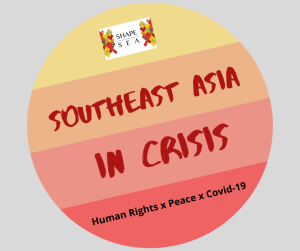Khoo Ying HooiSenior LecturerDepartment of International and Strategic StudiesFaculty of Arts and Social SciencesUniversity of Malaya
 Amid the United States (US)-China rivalry amid Covid-19, observers have begun to speculate the future geopolitical implications of this pandemic to Southeast Asia. Some suggest that this may likely reshape the global order, wherein Chinas position is expected to be elevated at the expense of the US. Some are also skeptical that China has the capacity to emerge as a dominant global power (Cimmino, Kroenig, and Pavel, 1 June 2020; Shin, 27 April 2020).Guided by this debate, this commentary would like to address how the US-China rivalry impact on Southeast Asia on the issues related to human rights and democracy?Before the pandemic, Beijings Belt and Road Initiative (BRI) was among the central issues in the region popularly debated under the framework of the expansion of Chinas soft power (Gong, 2019; Beeson, 2018), to the detriment of US influence; and how it may have impacts on human rights. The recent US announcement of giving China 72 hours to shut its Houston consulate (Griffiths and Gaouette, 22 July 2020) indicates the enhanced rivalry between the two powers.Amid the Covid-19, the Chinese government has pivoted to providing assistance popularly known as mask diplomacy (Wong, 25 March 2020), with Southeast Asian countries as a particular focus. Although there have been criticisms on Chinas approach, Chinese aid and diplomacy have thus far seemed to be better publicised and received in Southeast Asia than US assistance.Before we move on to answer how will the US-China rivalry impact on Southeast Asia on the issues related to human rights and democracy, we need first to understand why there is a “war” between the two powers on human rights. The US is conventionally known as a democracy, while China is known as more authoritarian and autocratic (Ambrosio, 2012). Two reasons for the disagreement between the two on human rights lie in the different economic development levels and the divergent cultures and fundamental values. All these are due to the competing perspectives deeply rooted in the different historical, ideological, political, and social conditions characteristic of each country (De Graaff and Apeldoorn, 2018; Yin, 2007). Such differences are glaring when we compare the approaches of the two countries amid the Covid-19.Thus far, none of the ASEAN member-states has openly criticised both countries on their initial handling of the pandemic. Most have demonstrated diplomacy of solidarity.Prior to the pandemic, the State of Southeast Asia: 2020 Survey Report by the Institute of Southeast Asian Studies (ISEAS) shows that 53.6 per cent of ASEAN elites generally choose to align with the US. However, country-level data present a more complex picture as seven ASEAN member states choose to align with China: Laos, Brunei, Myanmar, Malaysia, Cambodia, Thailand, and Indonesia; while Vietnam, Singapore, and the Philippines choose to be aligning with the U.S. Such trend is expected to stay more or less the same in the post-pandemic era.In Southeast Asia, the economic factor is a key concern in shaping Southeast Asian leaders’ decisions on critical issues that divide Washington and Beijing.The Covid-19 has been devastating for Southeast Asias economies. Millions are unemployed. Widespread perceptions hold that authoritarian system could be better in handling the crisis better than democracies. This is worrying as people may look toward a system outside of democracy. How leaders and their citizens interact with one another during the pandemic provides some clues to the future exercise of power. For now, the Covid-19 pandemic seems to be an affirmation of the support of an undemocratic government in Southeast Asia.In all, will human rights suffer amid the U.S.-China rivalry in this pandemic? While it is premature to make any generalisation and conclude that crisis management works better in a particular government system, there is a need to urgently address the correlation between salvaging the economy and the restoration of democracy and human rights.References:
Amid the United States (US)-China rivalry amid Covid-19, observers have begun to speculate the future geopolitical implications of this pandemic to Southeast Asia. Some suggest that this may likely reshape the global order, wherein Chinas position is expected to be elevated at the expense of the US. Some are also skeptical that China has the capacity to emerge as a dominant global power (Cimmino, Kroenig, and Pavel, 1 June 2020; Shin, 27 April 2020).Guided by this debate, this commentary would like to address how the US-China rivalry impact on Southeast Asia on the issues related to human rights and democracy?Before the pandemic, Beijings Belt and Road Initiative (BRI) was among the central issues in the region popularly debated under the framework of the expansion of Chinas soft power (Gong, 2019; Beeson, 2018), to the detriment of US influence; and how it may have impacts on human rights. The recent US announcement of giving China 72 hours to shut its Houston consulate (Griffiths and Gaouette, 22 July 2020) indicates the enhanced rivalry between the two powers.Amid the Covid-19, the Chinese government has pivoted to providing assistance popularly known as mask diplomacy (Wong, 25 March 2020), with Southeast Asian countries as a particular focus. Although there have been criticisms on Chinas approach, Chinese aid and diplomacy have thus far seemed to be better publicised and received in Southeast Asia than US assistance.Before we move on to answer how will the US-China rivalry impact on Southeast Asia on the issues related to human rights and democracy, we need first to understand why there is a “war” between the two powers on human rights. The US is conventionally known as a democracy, while China is known as more authoritarian and autocratic (Ambrosio, 2012). Two reasons for the disagreement between the two on human rights lie in the different economic development levels and the divergent cultures and fundamental values. All these are due to the competing perspectives deeply rooted in the different historical, ideological, political, and social conditions characteristic of each country (De Graaff and Apeldoorn, 2018; Yin, 2007). Such differences are glaring when we compare the approaches of the two countries amid the Covid-19.Thus far, none of the ASEAN member-states has openly criticised both countries on their initial handling of the pandemic. Most have demonstrated diplomacy of solidarity.Prior to the pandemic, the State of Southeast Asia: 2020 Survey Report by the Institute of Southeast Asian Studies (ISEAS) shows that 53.6 per cent of ASEAN elites generally choose to align with the US. However, country-level data present a more complex picture as seven ASEAN member states choose to align with China: Laos, Brunei, Myanmar, Malaysia, Cambodia, Thailand, and Indonesia; while Vietnam, Singapore, and the Philippines choose to be aligning with the U.S. Such trend is expected to stay more or less the same in the post-pandemic era.In Southeast Asia, the economic factor is a key concern in shaping Southeast Asian leaders’ decisions on critical issues that divide Washington and Beijing.The Covid-19 has been devastating for Southeast Asias economies. Millions are unemployed. Widespread perceptions hold that authoritarian system could be better in handling the crisis better than democracies. This is worrying as people may look toward a system outside of democracy. How leaders and their citizens interact with one another during the pandemic provides some clues to the future exercise of power. For now, the Covid-19 pandemic seems to be an affirmation of the support of an undemocratic government in Southeast Asia.In all, will human rights suffer amid the U.S.-China rivalry in this pandemic? While it is premature to make any generalisation and conclude that crisis management works better in a particular government system, there is a need to urgently address the correlation between salvaging the economy and the restoration of democracy and human rights.References:
- Ambrosio, T. (2012). The rise of the ˜China Model and ˜Beijing Consensus: evidence of authoritarian diffusion?. Contemporary Politics, 18(4), 381-399.
- Beeson, M. (2018). Geoeconomics with Chinese characteristics: The BRI and Chinas evolving grand strategy. Economic and Political Studies, 6(3), 240-256.
- Brian Wong. (25 March 2020). Chinas mask diplomacy, in The Diplomat. Retrieved at https://thediplomat.com/2020/03/chinas-mask-diplomacy/
- De Graaff, N., & Van Apeldoorn, B. (2018). US“China relations and the liberal world order: contending elites, colliding visions?. International affairs, 94(1), 113-131.
- Gong, X. (2019). The Belt & Road Initiative and Chinas influence in Southeast Asia. The Pacific Review, 32(4), 635-665.
- James Griffiths and Nicole Gaouette. (22 July 2020). US orders closure of Chinese consulate in Houston, in CNN. Retrieved at https://edition.cnn.com/2020/07/22/politics/china-us-houston-consulate-intl-hnk/index.html
- Jeffrey Cimmino, Matthew Kroenig and Barry Pavel. (1 June 2020). Executive summary: The virus and global order, in Atlantic Council. Retrieved at https://www.atlanticcouncil.org/in-depth-research-reports/issue-brief/executive-summary-the-virus-and-global-order/
- Kawashima Shin. (7 April 2020). Covid-10, China and the world order, in Nippon.com. Retrieved at https://www.nippon.com/en/in-depth/d00553/covid-19-china-and-the-world-order.html
- The State of Southeast Asia: 2020 Survey Report. (2020). ISEAS: Singapore. Retrieved at https://www.iseas.edu.sg/images/pdf/TheStateofSEASurveyReport_2020.pdf
- Yin, J. (2007). The clash of rights: A critical analysis of news discourse on human rights in the United States and China. Critical Discourse Studies, 4(1), 75-94.





